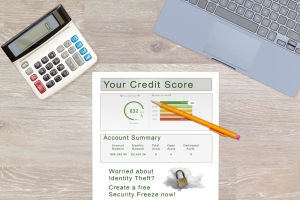
At the beginning of 2023, the total of U.S. credit card debt remained at $986 billion, unchanged from the end of 2022 – according to a Federal Reserve Bank of New York report on household debt. In addition, credit card balances are up 20% from a year ago, according to a recent report from TransUnion. The average balance was found to have risen $5,733 over that same period. These figures are astonishing, however as inflation continues to rise – many consumers have turned to their credit cards to purchase items they feel they need to continue their standard of living. Continue reading to discover ways to avoid credit card debt, and if you’re currently in debt – how to fix it.
Avoiding Credit Card Debt
Know your numbers. Do you know what your Annual Percentage Rate (APR) is on the credit card you use most frequently? If you pay your balance off in full each month, this number might not make a difference to you – but if you carry a balance, you’ll want to make sure it’s on a credit card with as low of an APR as possible. This number determines the interest you’ll pay each month for carrying a balance. And the bigger the balance, the more you’re going to pay in interest. Credit unions have a maximum APR of 18% on all credit cards. Be sure to stop into your local credit union to inquire, or if you live, work, worship, volunteer or attend school in Monmouth or Ocean Counties in NJ – check out our four great consumer credit card options.* We’re sure there’s one out there for you!
You’ll also want to pay attention to if your credit card offers a grace period on payments, if there’s an annual fee associated with your card, what your monthly payment due date is, and if there are any additional fees. Note that late and annual fees can add a balance that you weren’t expecting, which can be worrisome if you’re already carrying a high balance that you’re having trouble paying.
Use your credit card as just that. Using your credit card for anything other than making occasional purchases within your budget, can cause you to rack up more debt from fees and other service charges. For example, using your credit card to make a cash advance, using your credit card at an ATM, or to make a balance transfer can end up costing you more in the long run. Taking a cash advance out of your card balance or using your credit card at an ATM for cash, typically come with higher interest rates on the cash advance and fees for using the service. While a balance transfer promotion offering a lower APR to transfer your balance from another higher rate card might seem attractive, if you don’t pay off that balance within the promotional period or make any new purchases on that card – you may be paying anything remaining after the promotion ends at an even higher interest rate (plus any initial balance transfer fees for using the service). The moral of the story here is – if you are going to use a credit card, use it for regular purchases only that you can afford to pay off within the current billing cycle (usually 30 days).
Avoid auto-saving your card online. If your credit card is saved online within a website you frequently shop, an app, or your mobile phone – delete it. If one-click impulse buying is a problem for you, manually having to get your credit card and type the numbers in for every purchase should really make you evaluate whether that purchase is worth it or not.
Don’t carry your card on you all the time. If you’re always reaching into your wallet for that certain credit card, leave it at home and only take it out when you absolutely need it. This will also stop impulse buying, and you’ll have to plan out your trip to the store you want to use the card at and can decide if you truly need and can afford the item(s).
Already in Credit Card Debt? Here are some ways to fix it:
Evaluate what and where you charge. Start with a monthly budget. You can’t pay off debt if you don’t actually know what’s coming in and going out each month. This will give you the real numbers you need to work with so you know how much you bring in on a monthly basis, and what bills you need to pay in that month with that income. Anything else that is not a necessity should be stopped until your credit card debt is paid off.
Make a plan for paying off your debt. The best approach here, especially if you have multiple credit cards to pay off – is tackling the one with the highest interest rate first. Pay this card all the way down and then move onto the card with the next highest interest rate until all are paid off. Do not charge any additional purchases to any credit cards during this payoff period.
Take out a personal loan from your credit union. Instead of continuing to rack up debt and pay more in interest on high rate credit cards, take out a lower rate personal or consolidation loan from your local credit union.** Use the loan to pay off all your credit card debt, don’t make any additional credit card purchases, and then tackle paying off that personal loan. You’ll pay off your debt at a much lower interest rate, and your credit score may even improve since you’ll be reducing your credit utilization at the same time.
Look for a long-term 0% balance transfer offer. While a short-term credit card balance transfer isn’t usually advisable, a longer term one which offers 0% on balance transfers for at least one year or longer – may work for you if you do it right. This means you will need to fully concentrate on paying off all your credit card debt within the balance transfer period. If that promotional period is 0% for 18 months, then all the debt you have transferred needs to be paid off by the end of that 18 months and no new charges – otherwise you risk adding on more interest at a higher rate for anything not paid off by the time the offer ends. This method requires strict planning and budgeting.
Open a high yield savings account. If you have any leftover funds at the end of each month in your budget, put them in a high yield savings account that will pay you some dividends for keeping your money in it. This will help you build a savings reserve and hopefully prevent you from accruing more debt while you’re trying to pay off your existing balance.
While credit cards can be a great financial tool and resource, it’s good practice to only use them as that. Always use a credit card in moderation, and avoid making tempting but unnecessary purchases on them. If you have questions about credit management or would like to make an appointment with one of our staff to help you with a game plan to pay off credit card debt – visit a local branch or call 732.312.1500.
*APR varies up to 18% for purchases, when you open your account based on your credit worthiness. The APR is 18% APR for balance transfers and cash advances. APRs will vary with the market based on the Prime Rate. Subject to credit approval. Rates quoted assume excellent borrower credit history. Your actual APR may vary based on your state of residence, approved loan amount, applicable discounts and your credit history. No Annual Fee. Other fees that apply: Cash advance fee of $10 or 3% of the total cash advance amount—whichever is greater (no maximum), Balance transfer fee of $10 or 3% of the balance—whichever is greater (no maximum), Late Payment Fee of $29, $10 Card Replacement Fee, and Returned Payment Fee of $29. A First Financial membership is required to obtain a Visa® Credit Card and is available to anyone who lives, works, worships, or attends school in Monmouth or Ocean Counties.
**APR = Annual Percentage Rate. Actual rate will vary based on creditworthiness and loan term. Subject to credit approval. Personal Loan repayment terms range from 12 to 60 months, and APRs range from 10.24% APR to 18% APR. Minimum loan amount is $500. Loan payment example: A $2,000 Personal Loan financed at 10.24% APR for 24 months, would have a monthly payment amount of $92.51. A First Financial Federal Credit Union membership is required to obtain a Personal Loan or Line of Credit, and is open to anyone who lives, works, worships, volunteers or attends school in Monmouth or Ocean Counties. A $5 deposit in a base savings account is required for credit union membership prior to opening any other account/loan.
 As the year hits its halfway point, it’s also the perfect time to hit pause and check in on your financial health – especially your credit. Your credit score plays a big role in determining your eligibility for loans, credit cards, rental applications, and more. While most people wait until they need credit to check on it, a mid-year review can help you stay ahead of any surprises. Not sure where to begin? Here are some things to consider that may help improve your credit score.
As the year hits its halfway point, it’s also the perfect time to hit pause and check in on your financial health – especially your credit. Your credit score plays a big role in determining your eligibility for loans, credit cards, rental applications, and more. While most people wait until they need credit to check on it, a mid-year review can help you stay ahead of any surprises. Not sure where to begin? Here are some things to consider that may help improve your credit score.




